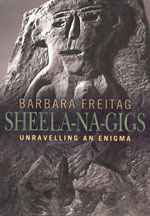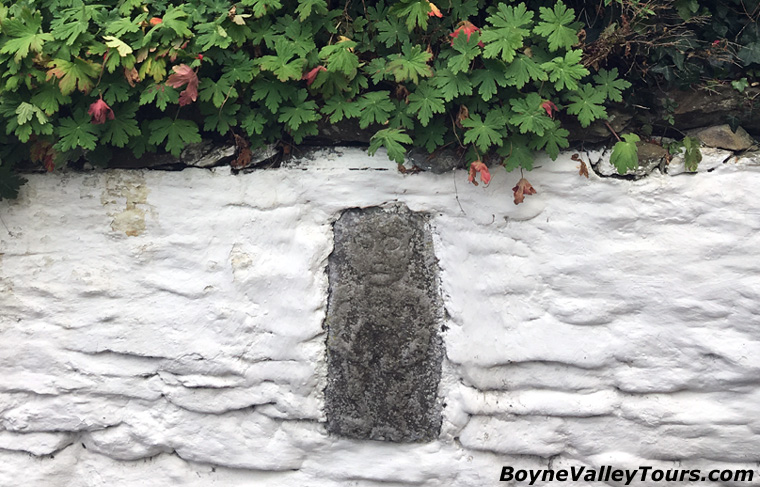Sheela-na-Gigs - Unravelling an Enigma by Barbara Freitag.
 For
centuries Sheela-na-gigs led a quiet existence on churches all over the British Isles.
When they were brought to scientific attention in Ireland, some 160 years ago, their discovery, understandably, was not greeted with an unqualified welcome.
For
centuries Sheela-na-gigs led a quiet existence on churches all over the British Isles.
When they were brought to scientific attention in Ireland, some 160 years ago, their discovery, understandably, was not greeted with an unqualified welcome.
After all, what were these carvings of naked females doing on medieval churches? And not only naked, but openly displaying their genitalia. Embarrassed clergymen and high-minded churchgoers physically removed and hid or destroyed the offensive figures. Archaeologists tended either to ignore them altogether or to label them as lewd, barbarous or repulsive.
Purchase at Amazon.com or Amazon.co.uk
Museums kept them locked away safely from public scrutiny
Only in the less puritanical atmosphere of the past few decades did academics as well as artists turn their interest to these carvings. Divergent views emerged as regards the origin and function of the Sheela-na-gigs. Some see them as ancient goddesses, some as vestiges of a pagan cult, others as protective talismans or good luck charms, to name but a few interpretations.The most favoured critical opinion, however, claims that they are copies of French sculptures put on Romanesque churches as warnings against lust, portraying evil in the battle against moral corruption. Although the reasons advanced for this view are rather unconvincing and, what is more, even contradicted by folk tradition, it has been widely accepted and found its way into dictionaries of art, museum guides and generally into all academic literature on the subject.
The definition of the name, Sheela-na-gig, took an equally surprising course. None of the constituents of the name is an unambiguously identifiable word. Yet a Gaelic pedigree was fabricated which, ironically, strangely contradicts the characteristic features of the sculpture. The problem with both interpretations is twofold. First, their justification is primarily based on a fortuitous resemblance: of form, in the case of the carving, of sound, in the case of the name. Second, they are assumptions imposed from the present on to the past, and from a biased academic on to a rural peasant background.
Sheela-na-gigs are not an urban phenomenon. The vast majority of the figures are found in simple country churches, predominantly in remote agricultural areas where, apart from obvious Christian iconography, they often represent the only form of artistic imagery. Judging by their crude realism and poor workmanship they appear to be produced by local amateur carvers rather than by skilled stonemasons. This suggests that the sculptures belong to folk art and a tradition, too important and too intimately bound up with the welfare of the common people to be disregarded by the Christian Church. Incorporated in a Christian context, but divorced from her roots in pre-Christian tradition, the Sheela-na-gig needs to be seen as some powerful manifestation of continuity with the past. The key to an understanding of her real meaning can thus only be found in a sympathetic appreciation of her medieval social context.
More specifically, in the following chapters I shall argue that the Sheela-na-gig belongs to the realm of folk deities and as such is associated with life-giving powers, birth and death and the renewal of life. Folk deities are found in peasant societies where they preside over certain 'departments' of life. Knowledge of the special power they exercise is transmitted orally and forms part of the folk tradition. Central to the survival of any rural society is the biological reproduction of its members, a close relationship with nature and a reverence for traditional custom. Placed in a cyclical agricultural pattern, the Sheela generally, it seems, was regarded as the guarantor of crops, animals and humans. But in particular, she was the divine assistant at childbirth who, at the same time, formed a link with the realm of the dead.
It will emerge from my investigation that the Sheela-na-gig was in great demand in medieval times, and that she had many sisters in other countries, who, while operating under different names and manifesting themselves in numerous other ways, fulfilled the very same role.
Download Sheela-na-Gigs - Unravelling an Enigma
Download PDF (10mb)
Boyne Valley Private Day Tour
 Immerse yourself in the rich heritage and culture of the Boyne Valley with our full-day private tours.
Visit Newgrange World Heritage site, explore the Hill of Slane, where Saint Patrick famously lit the Paschal fire.
Discover the Hill of Tara, the ancient seat of power for the High Kings of Ireland.
Book Now
Immerse yourself in the rich heritage and culture of the Boyne Valley with our full-day private tours.
Visit Newgrange World Heritage site, explore the Hill of Slane, where Saint Patrick famously lit the Paschal fire.
Discover the Hill of Tara, the ancient seat of power for the High Kings of Ireland.
Book Now
Home
| Newgrange
| Knowth
| Dowth
| Hill of Tara
| Fourknocks
| Loughcrew
| More Places
| Labyrinths
| Local Info
| Art Works
| Articles
| Images
| Books
| Links
| Boyne Valley Tours
| Contact
